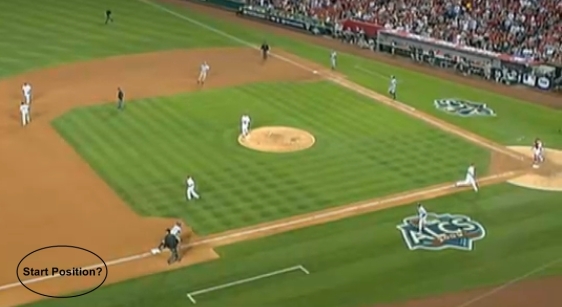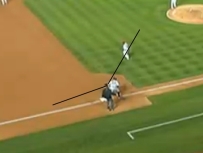By now, just about everyone knows about how umpire Jim Joyce blew a call during Armando Galarraga’s start against the Cleveland Indians, which cost him the 21st perfect game in major league history. Instantly after Joyce’s error was discovered, fans were calling for Joyce to be fired. However, he certainly isn’t the first umpire fans have wanted removed from the game, and he certainly won’t be the last.
For those that remember, Tim McClelland had his own controversy during the 2009 ALCS between the New York Yankees and the Los Angeles Angels. Long story short, during Game 4, Nick Swisher was at third base when Johnny Damon lined out to center fielder Torii Hunter. Swisher tagged up and presumably scored, until the Angels appealed that Swisher left third too early. McClelland agreed with the Angels and called Swisher out. Here is the video of the play. (Only the first 45 seconds is necessary to watch.)
From personal experience, it seems like we blame an umpire for a bad call without ever attempting to understand why the bad call was made. From the video, it’s clear that McClelland wasn’t directly watching Swisher when Torii Hunter caught Johnny Damon’s fly ball, but no one, not even FOX announcers Tim McCarver or Joe Buck, even bothered to explain why he wasn’t looking at Swisher. Back in October, I found a possibility as to why McClelland blew the call, and I will walk you through my reasoning here.
1. McClelland’s Positioning
Note: I have worked two summers as a baseball umpire for a middle school league. I understand that middle school children and professional athletes are very different, but I still had to learn positioning for certain plays, similar to the MLB umpires. During tag-up plays, I’ve been taught to line up the runner and fielder such that I can see both when the catch is made and when the runner’s foot leaves the base. Basically, this is exactly what you’d expect.
From the video I posted above, if you time when Damon made contact to when Hunter made the catch, it’s about 3.75 seconds. Now, I assumed that McClelland hesitated before making an attempt to get into a position to accurately watch Swisher’s tag because he had to decide on an appropriate reaction to the batted ball (similar to a fielder deciding what he has to do to field a batted ball). This is understandable because a person cannot be expected to know where or if a batted ball is going to be caught the very instant it is hit. Therefore, I assumed that it took McClelland about half a second to decide where the ball was going to land and if it had a possibility of being caught, so he should have had about 3.25 seconds (3.75 seconds of ball flight – 0.5 seconds of hesitation) to react. However, it’s tough to estimate this time because we don’t know exactly what he was thinking when Damon first made contact.

As for his starting position, it is virtually impossible to know where McClelland started because there isn’t any video I found that showed where he was at the beginning of the play. However, because of the rarity of a pickoff attempt at 3rd base and he was still in motion when Swisher left 3rd, I decided that he wasn’t close to the base when the play started. So, another assumption I made was that he was probably a distance from 3rd base that roughly mirrored the positioning of the 1st base umpire when Damon put the pitch into play.
The fact that McClelland was moving when Swisher left 3rd base poses a question: Why wasn’t he in position yet?
A. He hesitated longer than the 0.5 seconds I assumed and he didn’t move fast enough to compensate.
B. His hesitation was close to my 0.5 second estimate, but he was slow in moving to his position.
Look at the picture above again. The center of the oval where I think McClelland started to where he ended up at the time of Swisher leaving 3rd is roughly 1/4 the distance of the basepaths, or about 22.5 feet. Now, from my quick Google research, I found that the average walking speed is about 3 MPH and the average jogging speed is about 6 MPH. Accounting for McClelland’s age, I decided that his jogging speed was about 4.5 MPH. Doing the math, he should have taken about…
(4.5 mi/hr) x (1 hr / 3600 sec) x (5280 ft / 1 mi) = 6.6 ft/sec
22.5 ft / (6.6 ft / sec) = 3.41 sec
…to move from where he started to where he ended, which is very close to the 3.25 seconds I estimated earlier. So, I’m willing to bet that the correct answer was closer to B than A; he hesitated an appropriate amount of time, but didn’t move fast enough to get into position.
McClelland certainly could have gotten into a better position like I mentioned above, but only if he moved at a faster speed. However, from all of us watching many games, I’m sure we can all agree that umpires are not the fleetest of foot and rarely, if ever, even appear to move at a fast jog. I bet a jog for McClelland is probably a slow jog for the average person. Therefore, I think our answer evolves from B into a C that I didn’t even consider listing:
C. He did nothing wrong. The play just happened too fast, so he was in his best possible position.
2. McClelland’s Vision
No, I’m not recommending that he needed glasses (even after wrongly calling Cano safe at 3rd in the same game). Tim McCarver emphatically stated how McClelland wasn’t directly looking at Swisher, which caused his error in judgment. But what I couldn’t believe was that McCarver, nor Joe Buck, nor anyone else not even related to the FOX broadcast made any mention of peripheral vision in relation to this play. For this analysis, I found that this organization states that normal peripheral vision is about 180 degrees. Examine the following two pictures:


As you can understand, a person’s peripheral vision should decrease as he/she gets older, so I accounted for this by showing McClelland’s as being less than 180 degrees in the picture on the left. I know that I subjectively picked where the two lines are, but they are not intended to be exact nor did I even know what McClelland’s vision was like (neither should you), so I estimated that he saw at least part of Swisher before he left 3rd. Now, I’ve already shown that it was probable that the play in real time occurred too fast for McClelland to get into a good position to make an accurate call, so that was probably why he didn’t line up Swisher with Hunter when the catch was made. The picture on the right shows Swisher leaning forward in anticipation of leaving 3rd base. Once he started leaning, I think McClelland assumed that Swisher was off the base, and thus thought that Swisher had left the base before the catch was made. If the time of ball flight had been longer, McClelland could have gotten into a better position, and he most likely wouldn’t have wrongfully called Swisher out.
In review, I found that the time between when Johnny Damon made contact with Scott Kazmir’s pitch to when Torii Hunter caught Damon’s fly ball occurred too fast for Tim McClelland to properly move into position to line up Nick Swisher at 3rd base with Hunter in center field. With the probability that McClelland had declining peripheral vision, just like many people his age, he saw Swisher lean forward out of the corner of his eye, and thus thought that Swisher left the base much earlier than he actually did. Together, I feel that McClelland did the best that he could in making the correct call, but the play simply happened too fast for him.
Even if you feel that I made too many assumptions here, my main point of this article was for you to learn to understand why an umpire made a certain call before jumping to conclusions that he was out to get a certain player or team, or that he’s incapable of being a good umpire in MLB. You don’t need to go into as much analysis as I did here, but you can at least watch some replays on TV and see if they hint at why an umpire made a mistake. Umpires are not “out to get” particular teams or players. I want you to believe that these guys really are trying the best they can.
This article was originally posted on Off The Mark in October 2009. Portions of the article were rewritten for cohesiveness and relevance to the present.








